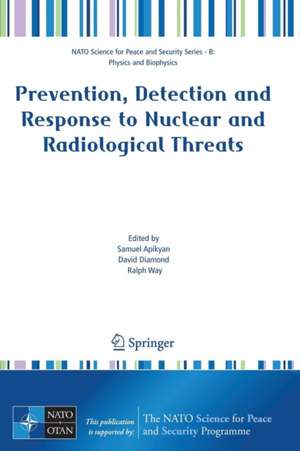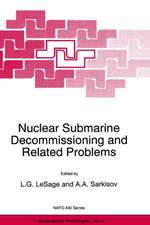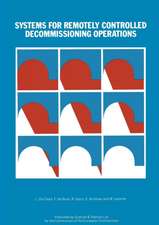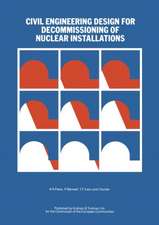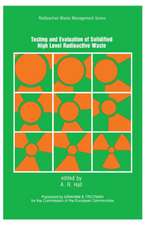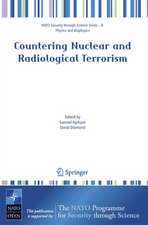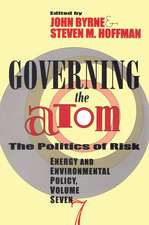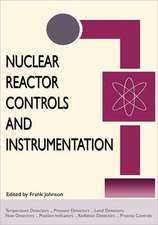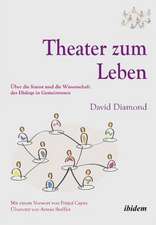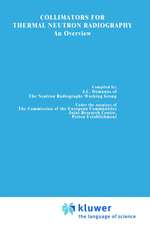Prevention, Detection and Response to Nuclear and Radiological Threats: NATO Science for Peace and Security Series B: Physics and Biophysics
Editat de Samuel Apikyan, David Diamond, Ralph Wayen Limba Engleză Paperback – 2 noi 2007
For this concern now we are aware and recognize, the first, that no single institution (no single country) possesses all the required assets to address these complex problems. It will require the formation of international science and technology teams that combine multiple scientific disciplines and span from basic research to systems engineering and manufacturing; the second, that fundamental scientific challenges must be overcome to achieve new and improved technologies that effectively counter radiological and nuclear threats.
The primary goal of any counter-terrorism effort is to prevent an attack as early in the development stages as possible. Many current approaches employed to prevent a nuclear/radiological attack rely upon detection of materials. Another general category of threat reduction involves preventing acquisition or utilization of the materials. Therefore while the organizers and participants of this meeting recognize that the Nuclear/Radiological threats is extremely broad, we necessarily limited the scope of this NATO Advanced Research Workshop and the programme focused on science and technology challenges associated with our need to prevent, detect and respond to Nuclear/Radiological threats.
The book can serve as a tool for communicating the outcomes of the workshop not only to the multi-national scientific and technical communities engaged in combating nuclear/ radiological terrorism, but also to those working at governmental and policy levels whose actions affect the directions thescience takes and how the technology is incorporated into country-specific national systems for combating nuclear/radiological terrorism.
| Toate formatele și edițiile | Preț | Express |
|---|---|---|
| Paperback (1) | 1217.90 lei 6-8 săpt. | |
| SPRINGER NETHERLANDS – 2 noi 2007 | 1217.90 lei 6-8 săpt. | |
| Hardback (1) | 1224.06 lei 6-8 săpt. | |
| SPRINGER NETHERLANDS – 22 oct 2007 | 1224.06 lei 6-8 săpt. |
Din seria NATO Science for Peace and Security Series B: Physics and Biophysics
- 18%
 Preț: 955.25 lei
Preț: 955.25 lei - 18%
 Preț: 1222.62 lei
Preț: 1222.62 lei - 24%
 Preț: 1057.17 lei
Preț: 1057.17 lei - 24%
 Preț: 788.31 lei
Preț: 788.31 lei - 18%
 Preț: 1223.74 lei
Preț: 1223.74 lei - 18%
 Preț: 1830.34 lei
Preț: 1830.34 lei - 15%
 Preț: 643.99 lei
Preț: 643.99 lei - 18%
 Preț: 1212.36 lei
Preț: 1212.36 lei - 18%
 Preț: 947.85 lei
Preț: 947.85 lei - 18%
 Preț: 950.52 lei
Preț: 950.52 lei - 20%
 Preț: 565.64 lei
Preț: 565.64 lei - 18%
 Preț: 950.66 lei
Preț: 950.66 lei - 24%
 Preț: 1060.06 lei
Preț: 1060.06 lei - 5%
 Preț: 1412.06 lei
Preț: 1412.06 lei - 18%
 Preț: 1226.90 lei
Preț: 1226.90 lei - 18%
 Preț: 945.79 lei
Preț: 945.79 lei - 18%
 Preț: 1221.20 lei
Preț: 1221.20 lei - 24%
 Preț: 789.61 lei
Preț: 789.61 lei - 18%
 Preț: 947.67 lei
Preț: 947.67 lei - 24%
 Preț: 1053.41 lei
Preț: 1053.41 lei - 18%
 Preț: 1834.77 lei
Preț: 1834.77 lei - 18%
 Preț: 943.08 lei
Preț: 943.08 lei - 15%
 Preț: 640.06 lei
Preț: 640.06 lei - 18%
 Preț: 945.30 lei
Preț: 945.30 lei - 18%
 Preț: 1217.62 lei
Preț: 1217.62 lei - 18%
 Preț: 951.14 lei
Preț: 951.14 lei - 18%
 Preț: 1216.02 lei
Preț: 1216.02 lei - 18%
 Preț: 1839.17 lei
Preț: 1839.17 lei - 15%
 Preț: 645.47 lei
Preț: 645.47 lei - 18%
 Preț: 1220.57 lei
Preț: 1220.57 lei - 18%
 Preț: 1228.96 lei
Preț: 1228.96 lei - 18%
 Preț: 1232.71 lei
Preț: 1232.71 lei - 15%
 Preț: 652.17 lei
Preț: 652.17 lei - 18%
 Preț: 1220.88 lei
Preț: 1220.88 lei - 15%
 Preț: 639.73 lei
Preț: 639.73 lei - 18%
 Preț: 1224.36 lei
Preț: 1224.36 lei - 18%
 Preț: 1828.29 lei
Preț: 1828.29 lei
Preț: 1217.90 lei
Preț vechi: 1485.24 lei
-18% Nou
Puncte Express: 1827
Preț estimativ în valută:
233.12€ • 253.30$ • 195.95£
233.12€ • 253.30$ • 195.95£
Carte tipărită la comandă
Livrare economică 22 aprilie-06 mai
Preluare comenzi: 021 569.72.76
Specificații
ISBN-13: 9781402066573
ISBN-10: 1402066570
Pagini: 315
Ilustrații: X, 308 p.
Dimensiuni: 155 x 235 x 22 mm
Greutate: 0.45 kg
Ediția:2008
Editura: SPRINGER NETHERLANDS
Colecția Springer
Seria NATO Science for Peace and Security Series B: Physics and Biophysics
Locul publicării:Dordrecht, Netherlands
ISBN-10: 1402066570
Pagini: 315
Ilustrații: X, 308 p.
Dimensiuni: 155 x 235 x 22 mm
Greutate: 0.45 kg
Ediția:2008
Editura: SPRINGER NETHERLANDS
Colecția Springer
Seria NATO Science for Peace and Security Series B: Physics and Biophysics
Locul publicării:Dordrecht, Netherlands
Public țintă
ResearchCuprins
Prevention.- From Cold War to International Terrorism.- Nuclear Terrorism: An Overview.- Prospects for Cooperative Threat Reduction Beyond the FSU.- Perspectives on International Radiological Trafficking.- Proliferation Resistance Features in Nuclear Reactor Designs For Small-Power Plants.- Integrated Border Management: R&D Activities at JRC.- Individual Protection Against Inhalation of Long Living Radioactive Dust Due to an Uncontrolled Release.- Contributions of Legislative, Regulatory and Institutional Infrastructures to Sustaining National Nuclear Security Regimes.- Identification, Assessment and Prevention of Different Environmental Risk-Factors Impact, Including Radiation, on the Population Health.- Detection.- Neutrinos, Dark Matter and Nuclear Detection.- Detection of ‘Dirty Bombs’ Using Nanosecond Neutron Analysis (NNA) Technique.- Ansi and IEC Standards for, and Evaluation of, Radiation Detection Instrumentation.- New Devices for the Detection and Identification of Radioactive Sources.- Perspectives of High Pressure Xenon Gamma-Ray Spectrometers to Detect and Identify Radioactive and Fissile Materials.- Experimental Model of the Device for Detection of Nuclear Materials by Pulsed Photoneutron Technology.- Radioecological Monitoring to the South Caucasus' Rivers as a Tool for Early Warning System.- Response.- Calibration of a Cloud Rise Model for a Rdd Scenario.- Application of a Decision Support System in Nuclear and Radiological Emergency: Opportunities and Challenges.- A 3D-Monte Carlo Based Dispersion Model for an Rdd or a Nuclear Terror Scenario.- Challenges in Responding to Incidents Involving the Malevolent use of Radiation.- French Emergency Response in Case of Dirty Bomb Threat.- Psychological and Social Response to a Nuclear Terrorist Event.-Cleanup and Site Restoration Strategy After a Radiological Terror Attack.- Activity Estimation of Gamma-Ray Emitting Sources Without the Preliminary Knowledge on a Shielding Design. Simulation and Experiment for NAI(TL) Detector.- Assessment of Radiological Risks and Possible Ecological and Economic Damages From Large-Scale Natural and Man-Induced Catastrophes in Ecology-Hazard Regionscatastrophes in Ecology-Hazard Regions of Central Asia and the Caucasus.- Results of Implementation of the State Program ‘Radiation’ in Georgia.
Caracteristici
Need to prevent, detect and respond to nuclear/radiological threats Connections are identified between technology needs and the underlying science and technology Research strategies are established that will advance the ability to counter nuclear/radiological threats
